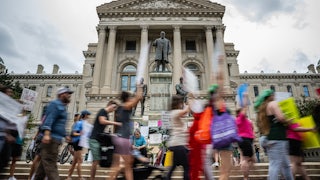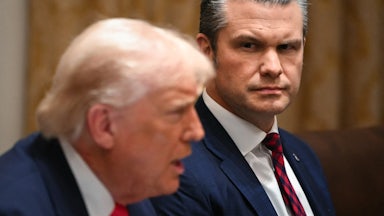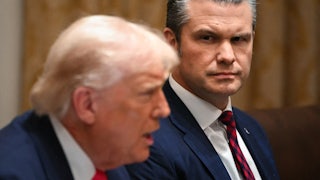If Iran’s ruling regime collapses—whether through elite fracture, mass uprising, or some kind of prolonged military encounter with the United States after last Saturday’s bombing—the post–Islamic Republic landscape will be defined by a fierce and uncertain contest among rival factions. The most likely players include: the military-security apparatus, hard-line Islamist ideologues, sidelined reformist technocrats, remnants of civil society, and exiled opposition groups. Their varying degrees of institutional power, ideological legitimacy, and public credibility will shape the nature of any transitional order. Let’s have a look at each.
1. The Military-Security Apparatus
The most immediate and organized force likely to assert control in a power vacuum is the Islamic Revolutionary Guard Corps, or IRGC. Much of its senior leadership has already been decapitated as part of Israel’s recent offensive. Still, a younger generation of officers—many battle-tested in Syria and Lebanon, indoctrinated, and trained—remains. The IRGC serves as the backbone of Iran’s internal repression, with its Basij paramilitary wing now deployed across the country not to ensure security but to instill fear and preempt popular mobilization. Recent reports suggest that Supreme Leader Ali Khamenei has already transferred key powers to the IRGC’s Supreme Council. In a post-collapse scenario, we could expect a Pakistan-style outcome: a military-led theocracy lite, stripped of ideological grandeur, with a reduced role for the clergy, but wielding brute control—a shabby, brittle tyranny of the sort that’s all too common across the region.
2. The Hard-Line Principalists
Aligned closely with the IRGC, Iran’s fundamentalist political factions—known as the “principalists”—comprise the regime’s most zealous Islamist ideologues (and cynical opportunists) within the Islamic Consultative Assembly (the Majlis, or parliament) and affiliated networks. While lacking the capacity to rule on their own, they are well positioned to form an alliance with the military. The resulting order could resemble a hybrid of Syria’s recently deposed secular-Islamist Baathist regime and Pakistan’s Islamo-military state: authoritarian, ideological, and cloaked in the rhetoric of “Islamic democracy.”
3. The Muslim Reformists
Among the most desirable—though less powerful—factions are the Muslim democrats who emerged from the reform movement dating to the presidency of Mohammad Khatami from 1997 to 2005. These former ministers, technocrats, and politicians were purged after the 2009 Green Movement protests (during which I myself was imprisoned). While their political parties and newspapers are banned, many of them remain in Iran. They know how to run ministries and could govern effectively. Crucially, many have moved beyond the dream of an Islamic state, embracing political pluralism in the spirit of Tunisia’s Ennahda party. They may still express rhetorical solidarity with the Palestinian cause and remain wary of foreign intervention, but they no longer seek power through divine mandate.
Their weakness lies in their ambivalence: a reluctance to abandon symbolic loyalty to Ayatollah Khomeini, which alienates the younger, secular generation. To build a viable alternative, they must reconcile with the fact that the Islamic Republic’s founding mythology repels the very constituencies they need to reach.
4. Nationalist Army Officers
Some believe remnants of the regular army (Artesh), sidelined for decades by the regime’s preference for the IRGC (Sepah), could still reemerge. Though its leadership has been increasingly ideologized, nationalist elements may survive within its ranks—officers more loyal to the nation than the regime—who could align with reformists or civil society if the Islamic Republic begins to collapse. While evidence remains scarce and opaque, this possibility cannot be dismissed.
5. Civil Society: What’s Left of It
The reformists’ best hope is to forge a coalition with Iran’s long-repressed but resilient civil society. Despite relentless crackdowns, it remains the case that secular, women-led, and rights-oriented groups retain a submerged vitality. If the repressive lid lifts, they could reemerge quickly. But challenges abound: Islamic and Islamist nongovernmental organizations still outnumber secular-progressive ones. Some of the most influential civic groups—like the Iranian Writers Association—remain mired in third-worldist, anti-imperialist ideologies, unable or unwilling to fully break from the ultra-leftist, revolutionary ethos.
Moreover, while the reformists may be institutionally savvy, their half-hearted secularism and nostalgia for the Islamic Republic’s early days—rooted in their attachment to Ayatollah Khomeini’s charisma, which shaped their political coming of age, and the illusion that his revolution was essentially democratic and tolerant before being derailed by war and harder-line zealots—make it hard to forge genuine trust with liberal-minded youth who demand full separation of religion and state.
5. The MEK Wild Card
Among the most destabilizing actors is the People’s Mojahedin Organization of Iran, or MEK, a Stalinist-Islamist cult with no significant support inside the country. Though capable of isolated assassinations or sabotage, they are widely despised by Iranians—both for their ideology and their collaboration with Saddam Hussein during the Iran-Iraq War. While some American politicians (Rudy Giuliani among them) have cozied up to the MEK in exile, there is no serious evidence of U.S. support for them as a post-regime alternative. Still, if the conflict drags on and foreign powers seek a proxy force to avoid deploying their own troops, the MEK might be seen as a ready, fanatical armed option. While Israel’s intelligence capabilities suggest they don’t need the MEK, even limited operational use could give the group a foothold inside Iran—risking future power grabs and raising the specter of internal armed conflict or civil war.
6. The Monarchists
Reza Pahlavi, son of the late Shah, advocates a return to constitutional monarchy. In theory, a figurehead monarchy akin to post-Franco Spain could offer symbolic unity and stability—especially if combined with a reformist–civil society coalition. In practice, however, Pahlavi’s support inside Iran appears minimal. Decades in exile and limited grassroots organization make his political base too narrow to mount a credible claim. As in Egypt’s 2012 elections, when liberals garnered only 5–10 percent of the vote, the monarchist constituency may prove more vocal than numerous.
7. The Imperial Question: Can Pride Yield to Pragmatism?
One of the most important yet under-discussed questions in a post-collapse scenario is the role of nationalism, xenophobia, and the enduring obsession with “imperialism.” With the exception of persecuted religious minorities—especially Jews—many Iranians across ideological and social lines seem to reserve their deepest hostility not for Islamist zealots or domestic oppressors but for foreign powers, especially the West. This hostility often appears so deeply rooted that even relatively benign Western influence is viewed with more suspicion than the regime’s own thuggery.
So a central question emerges: Will any of these factions or coalitions prove pragmatic enough to recognize that Iran’s future—its prosperity, freedom, and dignity—lies in rejoining the international community and forming alliances with the West, especially the United States? Or will the hubristic conceit of Persian exceptionalism once again sabotage a chance at national renewal?
Historical precedents abound: Post-regime collapse leaders like Václav Havel in Czechoslovakia or Konrad Adenauer in West Germany chose difficult but ultimately beneficial alliances with the West. Even India’s current nationalist leadership declares that while it is proudly non-Western, it is not anti-Western. A similar pivot—though painful—was made by Japan and Germany after World War II. The question is whether Iran’s reformists, civil society actors, and potential transitional leaders can overcome the misplaced pride and defensive nationalism that has too often derailed the country’s aspirations.
Conclusion
If the regime falls, the shape of the next Iranian state will be determined by who can organize fastest, command loyalty, and build coalitions across ideological divides. The military-hard-liner axis is well positioned to seize control, but a broad alliance of reformist technocrats, secular civil society actors, and perhaps even symbolic monarchism together with a nationalist army could offer a more humane and pluralist future. Whether Iran descends into postrevolutionary chaos or embarks on a democratic transition depends not just on who acts—but on how clearly they see the future and whether they understand that the changing world order increasingly pits an authoritarian axis—China, Russia, Iran, North Korea, Nicaragua, and others—against a still liberal and democratic West. That Western order may be troubled and contested, as is to be expected in dynamic free societies, but it remains the most viable path for those who seek freedom, dignity, and prosperity.






